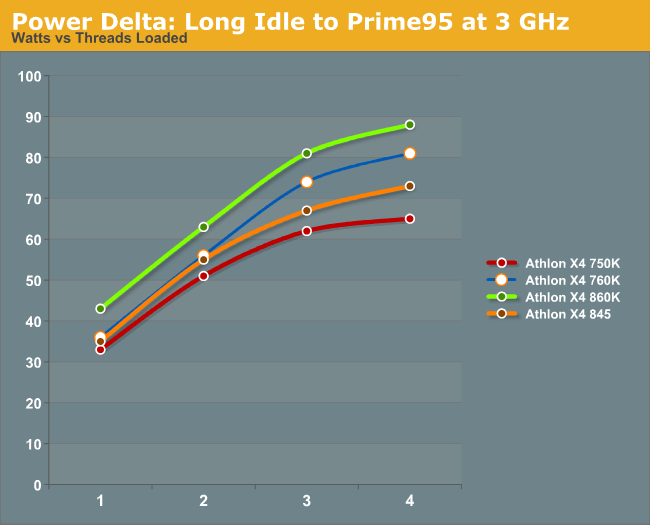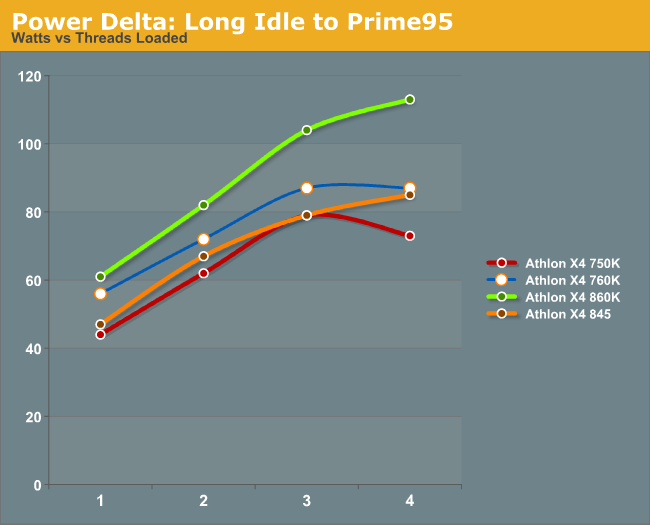AMD Carrizo Part 2: A Generational Deep Dive into the Athlon X4 845 at $70
by Ian Cutress on July 14, 2016 9:00 AM ESTPower Consumption
Power consumption was tested on the system while in a single MSI GTX 770 Lightning configuration with a wall meter connected to the power supply. This power supply is 80PLUS rated, and as I am in the UK on a 230-240 V supply, leads to ~75% efficiency > 50W, and 90%+ efficiency at 250W, suitable for both idle and multi-GPU loading. This method of power reading allows us to compare the power management of the UEFI and the board to supply components with power under load, and includes typical PSU losses due to efficiency.
Our Power Consumption tests have changed slightly since our last review as we are testing out new ways to represent the power used by the CPU and the system. The current three standard tests start with a system at long idle, meaning that the OS turns off the monitor and enters a lower power state without going into S3. We then move into a standard idle state on the desktop, with no software running but the desktop on display. The system is then moved into high performance mode, and we run a one-minute OCCT test to identify peak power consumption.
Due to extended requests, our power consumption numbers also use Prime95 to load the system. We use Prime95's peak power consumption mode, testing 1/2/3/4 thread consumption at the wall with our power meter. P95 hits the peak power relatively quickly, making this a straightforward test to include. For CPUs above 4 threads, we typically manage powers of two, half the CPU, and the full CPU to get an accurate picture.
For this review, we performed the power analysis for all four main CPUs at the 3 GHz frequency (using automatic voltage on the motherboard), as well as at stock frequencies. The values shown are delta values to the long idle power consumption, due to power delivery variations.
Generational Power Consumption at 3 GHz
All four processors have a 2-3W difference moving from a long idle to an idle state, however it is clear that our Carrizo CPU, which we stated is well outside its normal efficiency window at the beginning of this review, has a very good response during OCCT loading.

These results are within 3-4W of the full loading provided by Prime95 as well. If we analyze the per core jumps from moving up the threads using Prime95, there are some interesting numbers to pick out.

All the processors increase their power consumption by ~20W when both modules are loaded, when moving from 1 core loading to 2 core loading. When moving to 3/4 core loading, it is obvious that as both modules are already running at high frequency, a smaller amount of power is needed for each to enable the second thread.
Power Consumption at Stock
For those keeping track, we were not able to source identical TDP rated processors for this test. While the Carrizo based Athlon is 65W, the other processors are at the 95W/100W level. This makes total power consumption numbers relatively processional, and it becomes interesting looking into how close each processor gets to its TDP.
In our testing, the X4 845 seems to go beyond its 65W TDP, pushing almost another 9W through our power meter. This is only 8W away from the X4 750K, which should be 35W ahead. However, it would seem that for the X4 845, P95 draws an extra 15W compared to OCCT, but for the X4 750K, it draws 10W less, showing how difficult it can be to retain consistency. It is worth noting that TDP ratings are difficult to interpret in this way - the processors coming out of the fabs will have a statistical variation to their operating voltage, and this differs between samples. A good sample of a high TDP compared to a bad sample of a low TDP might seem to generate an interesting story, however without having access to several dozen units it can be strained to draw many conclusions.

Looking at the Prime95 core-loading numbers, we see a similar pattern to what happened at 3 GHz, despite the X4 760K getting the same power reading for 3/4 core loading and the X4 750K actually decreasing in power with four loaded threads.










131 Comments
View All Comments
mrdude - Thursday, July 14, 2016 - link
Fantastic work, Ian. Now if AMD put half as much work into their uArchs as you did into reviewing them, we might finally get somewhere =PGeranium - Thursday, July 14, 2016 - link
Ian,Exynos 7420 and Apple A9 is built on Samsang's 14nm LPE. Exynos 8890 and Snapdragon 820 is built on 14nm LPP.
Vlad_Da_Great - Thursday, July 14, 2016 - link
AMD CPU R&D has been outsourced pretty much close to an 1 year ago. Even Jim Keller left before anything(silicon) was remotely close to be released. AMD has submitted on the CPU front, and now with the another failure from the RX 480 power fiasco it seems in the GPU segment too. ZEN is just a myth for the small minded amoebas. The closest they can come to is Haswell, even in some benchmarks they will be far behind.Intel has reported times in many improvement over the 4/5y spam CPU's. AMD can barely get 30% and in some synthetic benchmarks they are below something was produced/developed half a decade ago.
TheinsanegamerN - Friday, July 15, 2016 - link
You have sources for your ludicrous claims?wumpus - Friday, July 15, 2016 - link
Zen tapped out. Thus the drawdown. But if you think Zen will compare as well to Intel silicon as the 480 does to the 1060, remember that Intel is still hand-laying out the transistors and AMD is using autorouters.Hopefully AMD will at least be able to get back to producing "the cheap stuff', but that is their best hope. They've pretty much surrendered.
Calculatron - Thursday, July 14, 2016 - link
Great article, overall! I am glad to see someone finally review the product.I was hoping, however, that you would come across this strange "throttling" issue that this CPU seems to have while playing certain games (not all games, just certain ones). Some people have started threads on Tom's Hardware, and I started one on AMD's own forums:
https://community.amd.com/thread/198618
http://www.tomshardware.com/answers/id-3054721/ath...
DominionSeraph - Thursday, July 14, 2016 - link
Yeesh, the barest overclock physically degrades the processor? This likely means it's degrading at stock as they've pushed a 35W part to 65W and beyond.Sherlock - Thursday, July 14, 2016 - link
/rantWho's your web-designer Anandtech - seriously - I see a big banner at the top & two big ads on the left & right of the page. I am so pissed by the design - I actually calculated the pixel count - only 24% of the screen is dedicated to content - excluding the large Anandtech logo & the menu bars - 10% for the screen is content - please don't kill the site with such crap
rant/
Also - "For clarity, hand was from AMD but not Lisa Su's" :)
DominionSeraph - Friday, July 15, 2016 - link
A narrow column is more readable. Who cares what's on the sides?The_Assimilator - Friday, July 15, 2016 - link
Ad blockers are your friend.